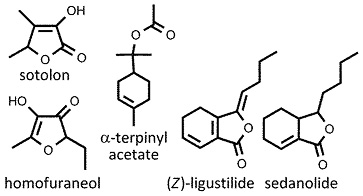 Levisticum officinale
Levisticum officinale
lovage
Back to “Salad herbs and herb mixtures: lovage (Levisticum officinale)”
Back to “Culinary herbs: lovage (Levisticum officinale)*”
Back to “Spices: lovage (Levisticum officinale)fr”
Levisticum officinale Koch (= Ligusticum levisticum L.) (Apiaceae); lavas, Maggikruid (Afrikaans); ou dang gui (Chinese); livèche (French); Liebstöckel, Maggikraut (German); levistico (Italian); ligústico (Spanish)
DESCRIPTION The leaves are compound, with broad, wedge-shaped leaflets that are toothed along the upper margins. They have a spicy, slightly bitter taste.
THE PLANT A sparse, erect perennial herb, up to 2 m (ca. 6 ft) high, with small yellow flowers arranged in flat-topped double umbels. Lovage is superficially similar to angelica (Angelica archangelica) but the latter is a more robust plant with leaflets toothed along their lower margins.
ORIGIN Eastern Mediterranean region.1 Lovage is said to represent the characteristic flavour of Roman cuisine (along with silphion and garum). It is now found throughout Europe and North America, not only as a cultivated herb and crop plant but also as a naturalized weed.1
CULTIVATION Plants are propagated from seeds or by division of the rootstocks. It tolerates partial shade and low temperatures and grows well in slightly alkaline, rich, well-drained soil.
HARVESTING For home use, healthy young leaves are picked as required. Extracts and essential oils are produced on a commercial scale from leaves and roots, harvested in autumn.
CULINARY USES Fresh leaves are still popular as a culinary herb in parts of Europe (mainly Britain, Germany and Romania), used in much the same way as celery. They are used in salads, soups, sauces, sour pickles, vinegars, new potatoes, stews and meat dishes. Blanched stems may be added to salads and can be candied (like angelica). Fruits are sometimes used as a spice. Above-ground parts are distilled to produce lovage leaf oil. The roots are eaten as a vegetable but are more often used in the form of extracts, essential oils or powdered dry root to flavour a wide range of food items, including alcoholic herbal tonics, liqueurs, confectionery, jellies, puddings, frozen dairy products, meat products, as well as savoury and sweet sauces.2
FLAVOUR COMPOUNDS Lovage is chemically complex. The leaf essential oil has α-terpenyl acetate as main compound (about 30%), accompanied by several alkylphthalides such as ligustilide and sedanolide. These compounds, which also give celery its distinctive flavour, represent the major portion (ca. 70%) of lovage root oil.3 Of special interest is sotolon (sotolone), the major aroma-impact compound in lovage leaves and roots,4 with a very low detection threshold. Sotolon has a spicy aroma at high concentrations but is caramel-like (maple syrup-like) at low concentrations. The German name for lovage is Maggikraut, named after Maggi sauce, a German spice sauce similar in appearance and taste to soy sauce and Worcestershire sauce. Maggi sauce contains neither lovage nor sotolon. However, it does contain homofuraneol, the 5-ethyl homologue of sotolon, to which the similarity in flavour can be ascribed.4

NOTES Lovage is used in traditional medicine as a carminative and diuretic.
1. Mabberley, D.J. 2008. Mabberley’s plant-book (3rd ed.). Cambridge University Press, Cambridge.
2. Harborne, J.B., Baxter, H. 2001. Chemical dictionary of economic plants. Wiley, New York.
3. Raal, A., Arak, E., Orav, A., Kalais, T., Muurisepp, M. 2008. Composition of the essential oil of Ligusticum officinalis W.D.J. Koch from some European countries. The Journal of Essential Oil Research 20: 318–322.
4. Blank, I., Schieberle, P. 1993. Analysis of the seasoning-like flavour substance of a commercial lovage extract (Levisticum officinale Koch). The Flavour and Fragrance Journal 8: 191–195.